#LemaClinic
Explore tagged Tumblr posts
Text
Experience a perfect transformation with Lema Clinic’s 100% digital smile design.
Treatment: Smile Design 👩🎨 Duration: 5 Days ⏳ System: 100% Digital System 🧑🏻🔬 Material: IVOCLAR Prime 😁
If you want to experience change with Lema Clinic’s 100% Digital System, please contact us. 📞
#lemaclinic#turkey#istanbul#bestdentalclinic#smile#smilemakeover#smilemore#dental#hollywoodsmile#dentalimplant#dentalcare#dentalcosmetics#dentaltourism#perfectsmile#amazing#bestoftheday#beauty
0 notes
Text
DENTAL CROWNS: ENHANCING SMILES
Dental crowns, undeniably a fundamental aspect of restorative dentistry, hold a crucial and transformative role in both rehabilitating and significantly enhancing the overall health and aesthetic appeal of teeth. This extensive and thorough guide thoughtfully delves into the multifaceted world of dental crowns, meticulously offering detailed insights into their diverse types, wide-ranging applications, numerous benefits, and various important considerations. Furthermore, it elaborates on their maintenance requirements and provides an in-depth analysis of cost implications, thus equipping readers with a comprehensive understanding of dental crowns and their significant impact in dental care.
Types of Dental Crowns
Porcelain or Ceramic Crowns: These crowns are highly celebrated for their ability to mimic the natural appearance of teeth. Ideal for front teeth restoration, porcelain or ceramic crowns blend seamlessly with the natural tooth color, providing a visually appealing solution. Their biocompatible nature minimizes the risk of allergic reactions, making them a safe choice. Moreover, their excellent aesthetic results are unparalleled, ensuring that these crowns not only restore function but also enhance the overall appearance of the smile.
Metal Crowns: Constructed from materials like gold, nickel, chromium, or palladium, metal crowns are synonymous with durability and strength. They excel in resisting wear and tear, making them an ideal choice for restoring molars, which endure significant force during chewing. Their less visible location in the mouth makes the metallic appearance less of a concern, and for those who appreciate it, these crowns can even add a unique aesthetic element.
Porcelain-Fused-to-Metal (PFM) Crowns: These crowns represent a harmonious fusion of strength and beauty. By combining the durability of metal with the aesthetic appeal of porcelain, PFM crowns provide a versatile solution suitable for various dental restoration needs. They offer the resilience required for long-lasting dental repairs while maintaining a natural look that complements the rest of the teeth.
Zirconia Crowns: Emerging as a popular choice in recent years, zirconia crowns are renowned for their exceptional strength and aesthetic appeal. These crowns are a testament to the advancements in dental materials, providing a robust solution that withstands the rigors of daily use while offering a visually appealing, tooth-like appearance. Their hypoallergenic properties make them an excellent choice for patients with sensitivities or allergies.
Composite Resin Crowns: As a more affordable option, composite resin crowns are accessible to a broader range of patients. While they may not offer the same level of durability as other types, their ease of repair and versatility in color matching make them an attractive option for those seeking a balance between cost and functionality. They are particularly useful in situations where a quick, aesthetic solution is needed.
In summary, the choice of dental crown material is a crucial decision that balances functional requirements, aesthetic preferences, and individual patient needs. Each type of crown offers its unique set of advantages, allowing dental professionals to tailor treatments that best suit their patients' specific circumstances.
The Process of Getting a Dental Crown
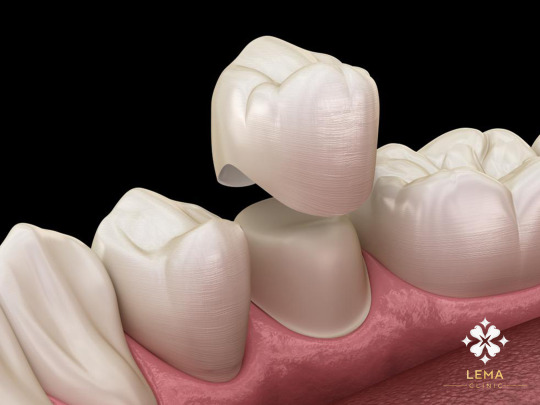
The procedure typically involves two visits to the dentist:
First Visit - Examination and Preparation: The dentist examines the tooth, takes X-rays, and prepares the tooth by reshaping it under anesthesia. An impression of the tooth is made for the crown fabrication.
Second Visit - Crown Fitting: The permanent crown is adjusted and cemented onto the prepared tooth, ensuring a proper fit and bite alignment.
Benefits of Dental Crowns
Restoration of Functionality: Crowns restore the strength, function, and usability of damaged teeth.
Aesthetic Enhancement: They improve the appearance of discolored or misshapen teeth.
Longevity: With proper care, crowns can last many years, making them a cost-effective solution.
Protection: Crowns safeguard a weakened tooth from further damage or decay.
Considerations and Potential Drawbacks
Sensitivity and Discomfort: Post-procedure sensitivity is common but usually temporary.
Risk of Damage or Loss: While strong, crowns can chip or become loose over time.
Maintenance Requirements: Like natural teeth, crowns require good oral hygiene practices.
Cost: The cost can be a consideration, as it varies depending on material and location.
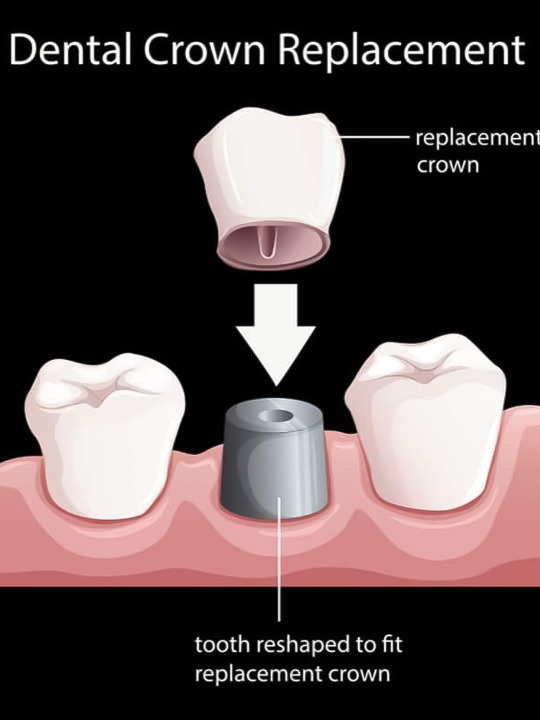
Maintenance of Dental Crowns
Maintaining dental crowns involves:
Regular brushing and flossing to prevent decay and gum disease.
Avoiding hard foods that can damage the crown.
Regular dental check-ups for professional cleaning and examination.
Cost Considerations
The cost of dental crowns varies based on the material, geographical location, and specific dental requirements. Insurance may cover part of the cost, depending on the policy.
Conclusion
Dental crowns offer a versatile and effective solution for various dental issues, significantly improving oral health and aesthetics.
Whether addressing decay, damage, or cosmetic concerns, crowns provide a long-lasting and reliable solution. It is essential for individuals considering this option to consult with a dental professional to understand the best choice for their unique needs.
0 notes
Text
TOP 10 SYMPTOM OF BRUXİSM
Bruxism is a movement disorder characterized by the clenching or grinding of teeth. It typically occurs during sleep or while awake and is classified into two types: primary and secondary. This condition is often unconscious and is more prevalent during emotional states like stress or anger. Regular or frequent teeth grinding can cause damage to the teeth and surrounding muscles. Bruxism manifests as the clenching, locking, or grinding of the upper and lower teeth. It appears as involuntary jaw movements or muscle contractions and is generally considered a functional disorder. This condition has the potential to cause tissue damage and can be triggered by various factors.
Top 10 Symptoms of Bruxism
Bruxism, commonly known as teeth grinding, is a condition often unnoticed by those who suffer from it. The primary symptoms include:
Teeth Grinding or Clenching: This might be loud enough to wake up a sleeping partner. Some individuals may grind their teeth unconsciously during the day or clench their jaw.
Teeth Wear and Damage: Over time, bruxism can lead to the flattening, fracturing, or chipping of teeth. Dentists often notice wear patterns on teeth during routine check-ups.
Increased Tooth Sensitivity: As the enamel wears down, teeth may become increasingly sensitive to hot, cold, or sweet foods and drinks.
Jaw Pain and Stiffness: Frequent grinding can lead to TMJ disorders, causing pain, discomfort, or stiffness in the jaw.
Headaches and Earaches: Bruxism often causes dull, constant headaches or earaches, typically originating from the temples.
Sleep Disruption: The act of grinding or clenching can disrupt sleep patterns, leading to insomnia or non-restorative sleep.
Facial Pain: Chronic bruxism can result in aching facial muscles and pain radiating towards the neck.
Chewed Cheek Tissue: Some people with bruxism may find themselves unintentionally biting the inside of their cheek.
Tooth Enamel Erosion: Over time, the constant grinding wears away the protective outer layer of the teeth.
Changes in Bite: In severe cases, bruxism can alter the way your teeth align, affecting your bite.
If you experience any of these symptoms, especially in combination, it's advisable to consult with a dental professional for an accurate diagnosis and appropriate treatment.
Long-Term Effects of Bruxism
Bruxism, or chronic teeth grinding, can have significant long-term effects if not addressed appropriately. Over time, the continuous grinding and clenching of teeth can lead to the wearing down of the tooth enamel, the outer protective layer of teeth. This erosion exposes the underlying softer dentin, making teeth more susceptible to decay and sensitivity. As the condition progresses, individuals may experience increased tooth sensitivity and even pain when consuming hot, cold, or sweet substances.

The constant pressure and motion can also contribute to the development of Temporomandibular Joint Disorder (TMJ), a condition that affects the jaw joint and surrounding muscles, leading to pain, difficulty in moving the jaw, and sometimes a clicking or locking sensation. TMJ disorders can significantly impact an individual's quality of life, causing discomfort during everyday activities like eating and speaking.
In addition to dental issues, bruxism can have broader implications for overall health. The strain from clenching and grinding can lead to chronic headaches, earaches, and facial pain. The tension in the jaw and facial muscles can extend to the neck and shoulders, contributing to overall body stress and discomfort.
Furthermore, the disruption of sleep patterns is a common consequence of bruxism. The act of grinding teeth can be loud and disruptive, not only for the individual but also for a sleeping partner. This can lead to sleep disturbances and, over time, result in sleep deprivation, affecting cognitive functions, mood, and overall health.
Psychologically, the stress and pain associated with bruxism can contribute to anxiety and decrease in life quality. The chronic discomfort and potential self-consciousness about damaged teeth can impact social interactions and personal well-being.
Overall, the long-term effects of bruxism underscore the importance of early detection and intervention. Without proper management, it can lead to significant dental damage, jaw disorders, ongoing pain, and a general decline in both physical and mental health
Protect Your Smile: Consult Your Dentist About Bruxism Today
If you're experiencing symptoms of bruxism, such as teeth grinding or jaw discomfort, it's important to consult with a dentist for a comprehensive evaluation. Bruxism can lead to various dental issues, including tooth wear, increased sensitivity, and even damage to your teeth and jaw. A dentist can assess your condition and recommend the most effective treatment tailored to your needs.
Treatments may include the use of custom-fitted mouthguards to protect your teeth during sleep, or dental corrections if significant damage has occurred. Additionally, your dentist can provide guidance on managing stress, which is often a contributing factor to teeth grinding.
Remember, early intervention is key in preventing long-term damage and alleviating discomfort. Don't hesitate to schedule an appointment with your dentist to explore the best treatment options for your situation and ensure the health and longevity of your teeth and jaw.
Comprehensive Bruxism Care at Lema Clinic
At Lema Clinic, we offer specialized treatment for bruxism, a condition characterized by teeth grinding and jaw clenching. Our approach is tailored to address both the symptoms and the underlying causes of bruxism.

Bruxism treatment begins with a thorough examination to assess the extent of the condition.
Based on this, we may recommend a custom-fitted mouthguard, designed to protect your teeth from grinding during sleep.
This not only prevents further dental wear but also helps reduce jaw strain and headaches.
In cases where dental damage has occurred, including the need for dental implants, Lema Dental Clinic's professional team provides restorative treatments such as crowns, veneers, or implants to repair and protect your teeth. Additionally, we focus on the root causes of teeth grinding, offering stress management techniques and lifestyle advice to help mitigate factors that contribute to teeth grinding.
For patients with severe bruxism, we may suggest additional therapies such as muscle relaxants, physical therapy, or specific dental procedures to align the bite and relieve pressure on the jaw.
At Lema Clinic, we believe in a comprehensive approach to bruxism treatment, combining dental care with overall wellness strategies. Our goal is to not only treat the symptoms but also to provide long-term solutions for our patients' dental health and comfort.
0 notes
Text
UNDERSTANDING DENTAL TARTAR AND ITS EFFECTS
Dental tartar, commonly known as dental plaque, is a hard deposit that forms on the teeth when plaque, a sticky film of bacteria, hardens. This calcification process occurs when plaque is not removed regularly through brushing and flossing. Over time, the accumulation of minerals from saliva can turn plaque into a tough, crusty deposit.

Tartar can vary in color, ranging from yellow to brown, and is most commonly found along the gumline and between teeth.
Unlike plaque, which is soft and can be easily removed with proper oral hygiene, tartar is firmly attached to the tooth enamel and can only be removed by a dental professional using specialized tools.
The presence of dental calculus is not just a cosmetic issue; it poses significant risks to oral health. It provides an ideal surface for further plaque accumulation, increasing the risk of tooth decay and gum disease. Tartar buildup can lead to inflammation of the gums, a condition known as gingivitis, which can progress to more serious gum diseases if left untreated.
Regular dental check-ups and cleanings are crucial in managing tartar buildup. During these visits, dental professionals use scaling and polishing techniques to remove dental calculus and keep teeth and gums healthy. In addition to professional cleanings, maintaining good oral hygiene practices at home, including brushing twice a day and flossing daily, is essential in preventing the formation of tartar and maintaining overall oral health.
Dental Tartar Formation
Dental tartar, or dental calculus, forms as a result of the mineralization of dental plaque, which is a sticky, tooth stain film that constantly forms on our teeth. Plaque is primarily composed of bacteria, food particles, proteins, and saliva. When plaque accumulates and is not removed through regular brushing and flossing, it can harden into tartar within 24 to 72 hours.
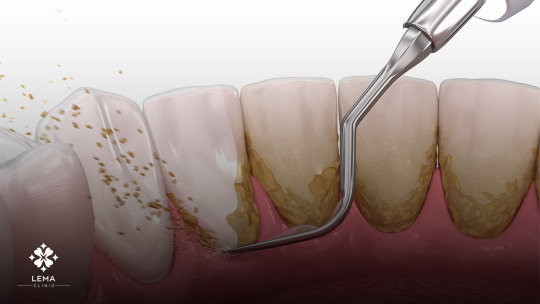
The mineralization process is facilitated by the calcium and phosphate ions present in saliva. These minerals interact with the plaque, leading to the formation of the hard, crusty deposit known as tartar.
The location of tartar formation is often at or below the gumline, where saliva and plaque tend to accumulate the most.
Tartar can create a rough surface that further attracts plaque and bacteria, creating a cycle of continued tartar formation. It's more challenging to clean and can lead to a range of oral health issues, including tooth decay and gum disease. Unlike plaque, which can be removed through regular oral hygiene, tartar can only be removed by a dental professional using specialized instruments. This is why maintaining good oral hygiene and regular dental check-ups are crucial in preventing the formation and buildup of dental calculus.
Expert Tartar Removal Services at Lema Dental Clinic
At Lema Dental Clinic, while we emphasize the importance of professional tartar removal for maintaining oral health, our services extend to a comprehensive range of dental treatments to cater to all your dental needs. Alongside dental calculus cleaning, we offer advanced teeth whitening procedures, providing you with a brighter, more confident smile. Our teeth whitening treatments are safe, effective, and tailored to each patient's specific requirements, ensuring optimal results while protecting your tooth enamel.
In addition to cosmetic services, Lema Dental Clinic specializes in restorative treatments such as dental implants. Dental implants are a durable and aesthetically pleasing solution for missing teeth, providing the functionality and appearance of natural teeth. Our experienced dental professionals use state-of-the-art technology to ensure that your dental implants are placed with precision and care, offering a long-term solution for tooth loss.
Our range of services also includes routine dental check-ups, fillings, crowns, veneers, and orthodontics. Each treatment is conducted with the utmost care and attention to detail, ensuring that you receive the highest standard of dental care.
At Lema Clinic, we understand that dental health is integral to overall well-being. Our team is committed to providing personalized treatments in a comfortable and welcoming environment. From maintaining your oral hygiene with dental calculus removal to enhancing your smile with teeth whitening and restoring functionality with dental implants, we are here to support all aspects of your dental health journey. Our goal is to ensure that every visit to our clinic contributes to the long-term health and beauty of your smile.
0 notes
Text
DENTAL DECAY AND TOOTH CAVITIES
Dental decay, often referred to as tooth cavities or dental caries, is a prevalent dental issue characterized by the deterioration of the tooth's protective outer layer, known as enamel. This decay occurs when various factors, such as inadequate oral hygiene, consumption of sugary and acidic foods, and the presence of harmful bacteria in the mouth, lead to the formation of small holes or cavities within the tooth structure. These cavities can range in size from tiny lesions to more extensive areas of decay.
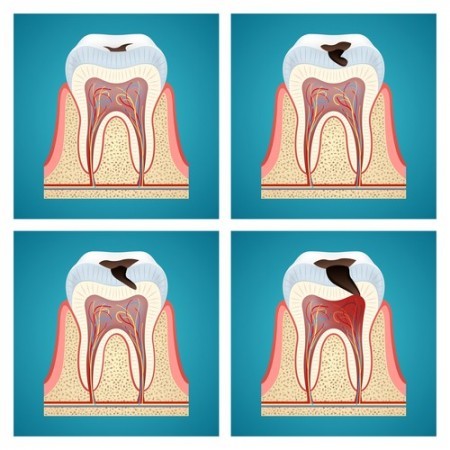
Dental decay is a progressive condition that can have a significant impact on oral health if left untreated. It typically begins when plaque, a sticky film of bacteria, forms on the teeth.
The bacteria in plaque produce acids when they come into contact with sugars from food and beverages. These acids gradually erode the enamel, causing it to weaken and lose its protective function.
Over time, the enamel breakdown can result in the formation of cavities, which can lead to tooth sensitivity, pain, and other complications.
Preventing dental decay involves maintaining good oral hygiene practices, including regular brushing and flossing to remove plaque and food particles. Additionally, a balanced diet that limits the intake of sugary and acidic foods can help reduce the risk of decay. The use of fluoride-containing toothpaste and drinking fluoridated water can strengthen enamel and make teeth more resistant to acid attacks.
If dental decay is detected, treatment is necessary to restore the affected tooth's structure. This typically involves dental fillings to fill the cavities and prevent further decay progression. In more advanced cases, treatments such as root canal therapy or dental crowns may be required to save the tooth and ensure oral health.
In summary, dental decay is a common condition where the enamel of a tooth deteriorates due to various factors, leading to the formation of cavities. Preventive measures, including good oral hygiene and a balanced diet, are essential to reduce the risk of decay, while early detection and proper treatment can help maintain healthy teeth and a vibrant smile.
Preventing Dental Decay: Tips for Healthy Teeth
Preventing dental decay is crucial for maintaining good oral health. Here are some key steps to help you prevent tooth cavities:
Maintain Proper Oral Hygiene: Brush your teeth at least twice a day with fluoride toothpaste, and don't forget to floss daily. This helps remove plaque and food particles that can lead to decay.
Balanced Diet: Limit your consumption of sugary and acidic foods and drinks. Opt for a diet rich in fruits, vegetables, and dairy products, which are good for your teeth.
Fluoride Use: Use fluoride toothpaste and consider fluoride treatments if recommended by your dentist. Fluoride strengthens enamel and helps protect against decay.
Regular Dental Check-ups: Visit your dentist regularly for check-ups and professional cleanings. Early detection of cavities allows for less invasive treatments.
Dental Sealants: Consider getting dental sealants on the chewing surfaces of molars, especially for children. These thin protective coatings can prevent decay in hard-to-reach areas.
Limit Snacking: Frequent snacking can increase the risk of decay. Try to minimize snacking between meals, especially on sugary or acidic snacks.
Stay Hydrated: Drink plenty of water throughout the day. Water helps rinse away food particles and bacteria from your mouth.
Chew Sugar-Free Gum: Chewing sugar-free gum, especially after meals, can stimulate saliva production, which helps neutralize acids and protect your teeth.
Mouthwash: Consider using an antimicrobial or fluoride mouthwash, but consult your dentist for recommendations.
Avoid Smoking and Excessive Alcohol: Both smoking and excessive alcohol consumption can contribute to dental problems, including decay. Quitting these habits can improve your oral health.
By following these preventive measures and maintaining a consistent oral care routine, you can significantly reduce the risk of dental decay and enjoy a healthier smile. Remember that early prevention is key to avoiding more extensive dental treatments in the future.
What Happens If Dental Decay Goes Untreated?
Dental decay, commonly known as tooth decay or cavities, is a common dental issue that can lead to significant health problems when left untreated. Understanding the potential consequences of untreated dental decay is crucial for maintaining good oral health. Here is an overview of what can happen if dental decay is not addressed:
Toothache: Untreated dental decay can progress deeper into the tooth, reaching the sensitive inner pulp. This can result in severe toothaches, causing discomfort and pain.
Infections: As decay advances, it can lead to infections within the tooth. Dental infections can cause swelling, abscesses, and severe pain. In some cases, the infection can spread to the surrounding tissues and even affect other parts of the body.
Tooth Loss: Severe dental decay can weaken the tooth structure to the point where the tooth becomes irreparable. In such cases, the tooth may need to be extracted or fall out on its own.
Spread of Decay: Untreated cavities can serve as breeding grounds for harmful bacteria, allowing the decay to spread to neighboring teeth. This can result in multiple teeth being affected by decay.
Gum Disease: Dental decay can lead to gum problems such as gingivitis and periodontitis. The presence of decay-causing bacteria can irritate the gums, causing inflammation, bleeding, and gum disease.
Tooth Sensitivity: As enamel erosion continues, teeth can become highly sensitive to hot, cold, and sweet foods and beverages, making eating and drinking uncomfortable.
Compromised Oral Health: Dental issues left unaddressed can impact overall oral health. It can lead to difficulty in chewing, speaking, and maintaining proper nutrition.
Aesthetic Concerns: Untreated dental decay can result in visible cavities, tooth discoloration, and bad breath, affecting your smile and self-confidence.
Financial Costs: Delaying treatment can result in the need for more extensive and expensive dental procedures, such as root canals, dental crowns, or even dental implants.
General Health Risks: There is evidence linking untreated oral infections, including those caused by dental decay, to systemic health problems like cardiovascular disease and diabetes.

In summary, dental decay left untreated can lead to various dental complications, including pain, infections, tooth loss, and gum disease.
Beyond dental problems, it can also have broader health implications. Therefore, it is essential to seek timely dental care, including regular check-ups and prompt treatment, to prevent the progression of dental decay and maintain overall well-being.
Proper Care For Dental Decay And Lema Clinic's
The health of your smile is a vital component of your overall quality of life. Therefore, preventing and treating dental issues like tooth decay is essential for maintaining a healthy mouth. Neglecting the care of dental decay can lead to discomfort, pain, and more severe health complications over time. We believe that patient education is essential. Lema Clinic's professional dentist team will guide you on proper oral hygiene practices, diet, and lifestyle choices to prevent dental decay and maintain your oral health.
Lema Clinic excels in restorative procedures such as dental fillings, crowns, and root canal therapy, helping patients regain their oral health and function.
In conclusion, preventing and treating dental decay is crucial for a healthy and beautiful smile. Lema Dental Clinic's commitment to dental health and its wide range of exceptional dental services make it a trusted partner in achieving and maintaining your optimal oral well-being. Don't compromise on your smile – choose Lema Clinic for a brighter and healthier future.
0 notes
Text
COMPOSITE BONDING IN DENISTRY
Composite bonding is a dental procedure used to improve the appearance and functionality of teeth. It involves the application of a tooth-colored composite resin material to the teeth, which is then shaped and polished to match the surrounding teeth, enhancing the overall smile.
This procedure is commonly used for several purposes:
Repairing Chipped or Cracked Teeth: Composite bonding can effectively restore the appearance of teeth that have been damaged due to injury or wear.
Closing Gaps: Small gaps between teeth can be filled in with composite bonding, creating a more uniform and aesthetically pleasing smile.
Improving Tooth Color: Teeth that are discolored or stained and cannot be corrected with teeth whitening can benefit from composite bonding. The resin can be closely matched to the natural color of the patient's teeth.
Changing Tooth Shape: Teeth that are misshapen or naturally too small can be reshaped with composite resin to create a more harmonious look.
Protecting Exposed Roots: When gums recede and expose the roots of the teeth, composite bonding can be applied to protect these areas from sensitivity and decay.
The process of composite bonding is relatively straightforward. It typically requires no anesthesia (unless it's being used to fill a decayed tooth) and is less invasive than other forms of dental restoration like crowns or veneers. The dentist will choose a resin color that matches the natural teeth and then apply the resin to the prepared tooth surface. The resin is then molded and smoothed before being hardened with a curing light. Finally, it's polished to give a natural appearance.
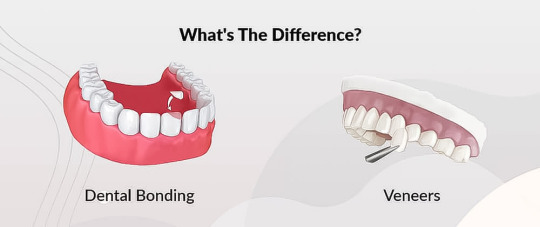
Composite bonding is a popular choice due to its cost-effectiveness and the speed of the procedure, often completed in a single visit. However, it's important to note that while composite resin can improve the appearance of teeth, it doesn't have the same strength as natural teeth and may need to be replaced or repaired over time.
Proper dental hygiene and regular check-ups are essential to maintain the results of composite bonding.
Step By Step Composite Bonding
Composite bonding is a straightforward and minimally invasive cosmetic dental procedure. Here's a step-by-step overview of how it's typically performed:
Color Matching: The dentist begins by selecting a composite resin color that closely matches the natural color of your teeth.
Tooth Preparation: The tooth surface is prepared to receive the bonding material. This usually involves lightly roughening the surface of the tooth with a gentle phosphoric acid solution, which helps the bonding material adhere.
Application of Composite Resin: The dentist then applies the composite resin to the prepared tooth. This resin is a putty-like material that can be easily shaped and sculpted.
Molding and Shaping: Once the composite is in place, the dentist will mold and smooth it to the desired shape. This step is crucial as it determines the final appearance of the tooth.
Hardening the Composite: After shaping the resin, the dentist uses a special light, typically an ultraviolet light, to harden and set the material. This process is known as curing and takes only a few minutes.
Polishing and Finishing Touches: Finally, the bonded tooth is polished to match the sheen of the rest of the teeth. This step ensures that the bonding blends seamlessly with the natural teeth, both in shape and in shine.
The whole process usually takes between 30 to 60 minutes per tooth and can be completed in a single visit. One of the advantages of composite bonding is that it requires minimal removal of the existing tooth enamel compared to other cosmetic procedures like veneers or crowns.
Composite Bonding Aftercare
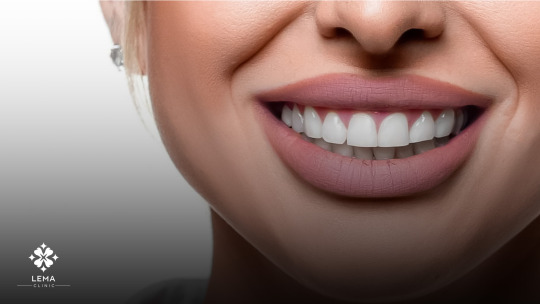
Composite bonding is a popular cosmetic dental procedure that requires careful maintenance to ensure its longevity and effectiveness.
Unlike more invasive procedures, composite bonding involves adding a resin material to the tooth's surface, which can be more susceptible to staining and damage if not properly cared for.
Firstly, it's essential to maintain good oral hygiene. Regular brushing and flossing are crucial to prevent the buildup of plaque and tartar, which can affect not only the health of your teeth and gums but also the appearance and integrity of the bonding material. Using a non-abrasive toothpaste and a soft-bristled toothbrush is recommended to avoid scratching the composite material. Regular dental check-ups are vital for maintaining composite bonding.
Lema Dental: Expertise in Composite Bonding
Lema Clinic has established a reputation for its excellence in composite bonding, a testament to its commitment to providing top-notch dental care. Their success in this specific treatment is a reflection of their broader expertise in a wide range of dental services.
At Lema Clinic, the team of skilled dentists and dental professionals specializes in composite bonding, employing advanced techniques and high-quality materials to ensure the best aesthetic and functional results. They understand the importance of a natural-looking smile and work meticulously to match the composite material to the natural color of patients' teeth. Their attention to detail in shaping and polishing the composite ensures that it blends seamlessly with the surrounding teeth, enhancing the overall appearance.
Beyond composite bonding, Lema Dental Clinic offers an extensive array of dental treatments. From preventive care like regular cleanings and check-ups to more complex procedures such as root canals, crowns, and bridges, they cover all aspects of dental health. Their expertise also extends to cosmetic dentistry, including teeth whitening and veneers, catering to patients seeking to improve their smile's aesthetics.
0 notes
Text
ENHANCING SMILES WITH CLEAR BRACES
Clear braces are a modern orthodontic treatment option designed to straighten teeth while offering a more aesthetic alternative to traditional metal braces. They are particularly popular among adults and older teenagers who are conscious about the appearance of braces but still wish to correct dental misalignments.
Unlike the easily noticeable metal braces, clear braces are made of transparent or tooth-colored materials, making them less visible. The brackets, which are attached to the front of each tooth, are typically made from a durable ceramic or plastic material that blends in with the tooth color. The wires connecting these brackets can also be made clearer or tooth-colored, further reducing visibility.
The functionality of clear braces is similar to traditional braces. They apply gentle yet consistent pressure on the teeth to gradually move them into the desired position over time. This makes them effective for treating a wide range of orthodontic issues, including crowded teeth, gaps, overbites, underbites, and other alignment problems.
One of the main advantages of clear braces is their aesthetic appeal. Many patients feel more confident and less self-conscious during their orthodontic treatment. However, they may require more attention to oral hygiene, as the clear materials can get stained by foods, drinks, or smoking. Regular brushing and flossing, along with avoiding certain stain-causing substances, are important for maintaining their discreet appearance.
Advantages of Opting for Clear Braces
Clear braces provide numerous benefits for those seeking orthodontic treatment:
Aesthetic Appeal: Their transparent or tooth-colored materials make them much less noticeable than traditional metal braces, ideal for adults and self-conscious teens.
Effectiveness: Clear braces are as effective as traditional braces in correcting dental alignment issues like overcrowding, gaps, and bite problems.
Comfort: They are often more comfortable than metal braces, with smoother materials reducing mouth irritation.
Oral Hygiene: The less obtrusive design can make it easier to maintain good oral hygiene, as food particles and plaque are more visible, encouraging thorough cleaning.
Confidence: Wearing clear braces can boost confidence during treatment, as they are less visible and do not alter the wearer's appearance as much.
Clear Braces Aftercare
"Clear braces", also known as invisible braces or clear aligners, are orthodontic devices used to straighten teeth as an alternative to traditional metal braces. They are designed to be less noticeable on the teeth and more aesthetically pleasing. The care and maintenance of clear braces are crucial for their effectiveness and to maintain oral hygiene.

Aftercare for clear braces involves several key practices. First and foremost, it is essential to maintain good oral hygiene.
This includes regular brushing and flossing to prevent the buildup of plaque and food particles.
Since clear braces are typically removable, it is easier to clean both the teeth and the aligners themselves. It is recommended to brush your teeth after every meal or snack and to clean the aligners as advised by your orthodontist.
Secondly, it's important to follow the wearing schedule prescribed by your orthodontist. Clear braces should be worn for the recommended number of hours each day to ensure they work effectively. Typically, this means wearing them at all times except when eating, drinking anything other than water, and during oral hygiene routines.
Another aspect of aftercare is avoiding certain foods and drinks that can stain the aligners or harm your teeth. This includes items like coffee, red wine, and highly pigmented foods. Smoking is also discouraged as it can discolor the aligners.
Regular check-ups with your orthodontist are crucial. These appointments allow the orthodontist to monitor the progress of the treatment and make any necessary adjustments to the aligners. It also gives you the opportunity to discuss any concerns or issues you may be experiencing.
In case of any discomfort or if the aligners cause irritation in the mouth, it’s important to consult with your orthodontist. They can provide solutions or adjustments to alleviate any problems.
Finally, when not in use, it is advisable to keep the clear braces in a protective case to avoid loss or damage. This also helps in maintaining the cleanliness of the aligners.

Overall, the aftercare of clear braces is about maintaining good oral hygiene, adhering to the prescribed usage routine, being mindful of food and drink choices, attending regular orthodontic appointments, and properly handling the aligners when not in use.
By following these guidelines, patients can ensure a successful and hygienic treatment process with clear braces.
Duration of Clear Braces Treatment: An Overview
The duration of dental treatment with clear braces varies depending on several factors, including the complexity of the dental issues being corrected, the age of the patient, and how well the patient adheres to the treatment plan. Generally, the treatment time for clear braces can range from 6 months to 24 months, but this can vary significantly.
For minor dental corrections, such as slight overcrowding or small gaps, treatment can be relatively short, often completed within 6 to 12 months. However, more complex dental issues, like significant misalignment, severe overcrowding, or bite problems, may require a longer treatment period, potentially extending to 24 months or more.
It's important to note that the effectiveness of clear braces also depends heavily on patient compliance. These braces are typically removable, and it’s recommended that they be worn for 20 to 22 hours per day. Failing to wear the aligners for the recommended duration each day can prolong the treatment time.
Lema Clinic's Success with Clear Braces and Comprehensive Dental Care
Lema Clinic has established itself as a reputable provider in the field of orthodontics, particularly with its use of clear braces. Renowned for their commitment to advanced dental technology and patient-centered care, Lema Clinic has a proven track record of successful treatments, including clear braces, which have become a popular choice for patients seeking discreet orthodontic solutions.
The clinic's success with clear braces is attributed to its personalized treatment plans and the expertise of its dental professionals. Lema Dental Clinic ensures that each patient's treatment is tailored to their specific dental needs, leading to more effective and efficient results. The use of clear braces at Lema Clinic offers a virtually invisible way to correct dental misalignments, making it an attractive option for those who are conscious about the appearance of traditional metal braces.
Beyond clear braces, Lema Clinic offers a range of dental treatments, each bearing the mark of their high success rates. These treatments include routine dental care, cosmetic dentistry, and more complex orthodontic procedures. The clinic's approach to cosmetic dentistry, for example, focuses on achieving natural-looking results that enhance the patient's overall appearance and dental health.
The success of Lema Clinic's treatments can also be attributed to its investment in the latest dental technologies and continuous professional development. This commitment ensures that patients receive the most advanced care possible, which is evident in the positive outcomes of their treatments.
#beautiful smile#gorgeous smile#lemaclinic#hollywood smile#smile#pretty smile#braces#metal braces#girls with braces#guys with braces
0 notes
Text
SINUS LIFT SURGERY FOR UPPER JAW IMPLANTS
A sinus lift, also known as sinus augmentation, is a surgical procedure in dentistry used to increase the amount of bone in the upper jaw, specifically in the area of the premolars and molars. This procedure is commonly performed when there is not enough bone height in the upper jaw, or the sinuses are too close to the jaw for dental implants to be placed.
The need for a sinus lift typically arises in situations where a patient has lost teeth in the upper jaw, especially the back teeth, and wants to get dental implants. Bone loss can occur due to several reasons, including periodontal disease, the natural process of aging, or the bone reabsorbing into the body because the teeth have been missing for a long time. When teeth are lost, the bone that previously supported those teeth begins to atrophy, often resulting in insufficient bone to support dental implants.
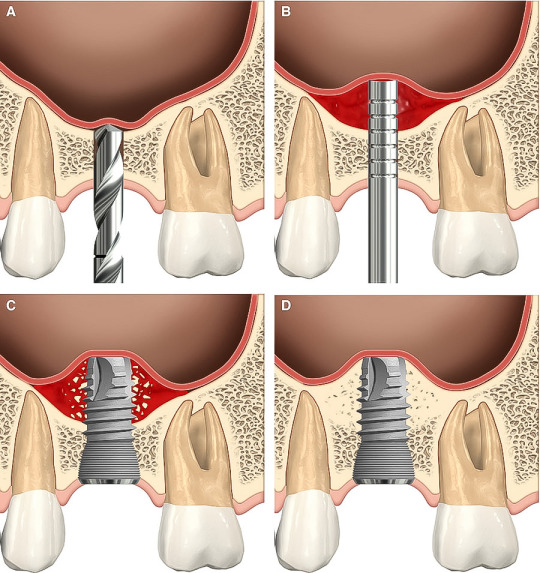
During a sinus lift procedure, the oral surgeon or dentist cuts the gum tissue near the premolars and molars of the upper jaw. This tissue is raised, exposing the bone underneath.
A small, oval window is opened in the bone, and the membrane that lines the sinus on the other side of this window is gently pushed upward. The newly created space is then packed with bone graft material.
This material can be taken from the patient's own body (autograft), from a cadaver (allograft), from cow bone (xenograft), or it can be a synthetic material.
After the bone is placed, the tissue is stitched back together.
The healing process can take several months as the grafted material fuses with the patient's bone. Once healing is complete, the bone becomes a part of the patient's jaw, providing a solid foundation to place implants. A sinus lift is considered a safe and effective procedure, but as with any surgery, there are some risks and complications that can occur. These can include infection, sinus membrane perforation, bleeding, and swelling. However, these complications are rare, and when performed by a skilled and experienced dental professional, a sinus lift usually has a high success rate. Overall, a sinus lift is an important and beneficial procedure for individuals who lack sufficient bone height in their upper jaw but wish to have dental implants. It allows for the successful placement of implants, which can lead to improved oral function and aesthetics.
Healing Process After Sinus Lift Surgery
The healing process following a sinus lift surgery, a crucial procedure for successful dental implant placement in the upper jaw, involves several stages and requires careful management to ensure optimal outcomes. Here's an overview of what patients can expect during the recovery period:
Immediate Postoperative Care: In the first few days after the sinus lift, patients are likely to experience some swelling and mild discomfort. Bleeding from the surgical site is common, but it usually subsides within a few days. Patients are advised to avoid strenuous activities and to keep their head elevated to reduce swelling.
Medication and Pain Management: Pain management is an important aspect of postoperative care. Your oral surgeon may prescribe pain relievers and antibiotics to prevent infection. Following the prescribed medication regimen is essential for a smooth recovery.
Diet and Oral Hygiene: During the initial recovery phase, patients are advised to eat soft foods and avoid hot beverages. Chewing should be done away from the surgical site. Maintaining oral hygiene is critical, but brushing and flossing around the surgical area should be done gently to avoid disturbing the healing tissues.
Activity Restrictions: Patients are typically advised to avoid blowing their nose or sneezing forcefully for a few weeks after the surgery. These actions can increase sinus pressure and disrupt the healing process. Smoking should also be avoided as it can impede healing and increase the risk of complications.
Follow-up Visits: Regular follow-up appointments with the dental surgeon are crucial. These visits allow the surgeon to monitor the healing process and ensure that the graft is integrating properly with the existing bone.
Bone Healing and Integration: The most significant part of the healing process is the integration of the grafted material with the patient's natural bone. This can take several months, usually between four to nine months, depending on individual cases. Only after the graft has successfully integrated and healed can the dental implants be placed.
Monitoring for Complications: While rare, complications such as infection, sinus membrane perforation, or graft failure can occur. Patients should be vigilant and report any unusual symptoms such as severe pain, persistent swelling, or signs of infection to their surgeon immediately.
Long-term Care: Once healed, the augmented bone in the sinus lift should be treated with the same care as natural bone. Good oral hygiene practices and regular dental check-ups are essential for maintaining the health of the implant site.
The recovery process from a sinus lift surgery is a gradual and important phase. Patients need to follow their surgeon's instructions closely and maintain good oral health habits to ensure the best possible outcomes and the successful placement of dental implants.
Sinus Lift Expertise and Quality Dental Services at Lema Clinic
Lema Dental Clinic, renowned for its expertise in dental procedures, particularly excels in sinus lift surgeries - a key solution for patients requiring dental implants in the upper jaw with insufficient bone density. The clinic's success in sinus lifts stems from its use of advanced techniques and high-quality materials, ensuring safe and effective treatments. Patients experience a smooth and expedited healing process, thanks to the meticulous care and follow-up provided.
Beyond sinus lifts, Lema Clinic boasts a wide range of dental services, including cosmetic dentistry, periodontal treatments, endodontics, and pediatric dentistry. Each treatment is carried out by specialist dentists using state-of-the-art technology and adhering to the highest standards of hygiene.
The clinic's commitment to excellence is further highlighted in its VIP services, offering personalized care and comfort to ensure an exceptional patient experience. Lema Dental Clinic's comprehensive approach to dental health and aesthetics marks its distinguished position in the field of modern dentistry.
#beautiful smile#gorgeous smile#lemaclinic#hollywood smile#smile#pretty smile#implant#dental implants
0 notes
Text
CHOOSING THE RIGHT TOOTHPASTE
Toothpaste plays a crucial role in maintaining and improving oral health. Here are several key reasons why toothpaste is important:
Cavity Prevention: Toothpaste often contains fluoride, which strengthens tooth enamel and helps prevent tooth decay. By making teeth more resistant to acid attacks from bacteria in the mouth, fluoride reduces the risk of cavities.
Plaque and Tartar Control: Toothpaste aids in the removal of plaque, a sticky film of bacteria that forms on the teeth and gums. If plaque is not removed, it can harden into tartar, which is much more difficult to remove and can lead to gum disease.
Gum Disease Prevention: Regular brushing with toothpaste helps prevent gum diseases like gingivitis, an inflammation of the gums. Advanced gum disease can lead to more serious health problems, including tooth loss.
Whitening: Many types of toothpaste contain mild abrasives or special ingredients that help remove surface stains from the teeth, leading to a whiter and bright smile.
Bad Breath Reduction: Toothpaste helps freshen breath by removing bacteria that cause odor. It also often contains flavoring agents like mint, which leave a pleasant taste and smell.
Sensitivity Reduction: For those with sensitive teeth, specially formulated toothpastes can help reduce discomfort by blocking pathways through the teeth that attach to nerves inside.
Oral Hygiene Education: The use of toothpaste is often the first step in educating children and adults about the importance of oral hygiene, including regular brushing and flossing.
In conclusion, toothpaste is a fundamental component of daily oral hygiene. It not only cleans teeth but also provides a range of benefits that help maintain the health of the mouth and overall wellbeing.
Selecting the Perfect Toothpaste
Selecting the right toothpaste is critical for maintaining optimal oral health. Different types of toothpaste cater to various dental needs, making it essential to choose one that aligns with your specific oral health requirements.
Firstly, the presence of fluoride in toothpaste is crucial for preventing tooth decay and strengthening enamel. Fluoride acts as a protective barrier against acid attacks from bacteria, reducing the risk of cavities.
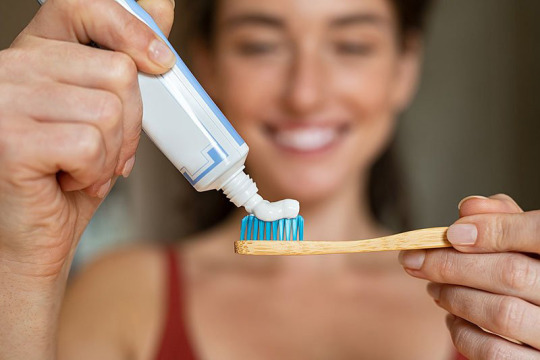
For those with sensitive teeth, toothpaste formulated for sensitivity can provide relief. These types contain compounds that block the pathways linked to nerve receptors inside the teeth, reducing discomfort from hot or cold stimuli.
Whitening toothpastes are beneficial for those looking to remove surface stains and brighten their smile. They contain mild abrasives or chemicals that effectively polish the teeth, offering a cosmetic benefit while maintaining cleanliness.
If gum health is a concern, toothpastes designed to combat gingivitis can be useful. They often contain ingredients that help control plaque and reduce inflammation of the gums, preventing gum diseases.
For individuals with specific dental issues like tartar buildup, smoker's stains, or bad breath, specialized are available. These products are formulated to address these unique concerns more effectively than regular toothpaste.
In summary, the right toothpaste can significantly contribute to overall dental health, addressing specific oral health concerns and enhancing the effectiveness of daily brushing. Thus, understanding and selecting the most appropriate toothpaste is an integral part of oral hygiene.
Fluoride vs. Fluoride-Free Toothpaste
When it comes to choosing between fluoride and fluoride-free, understanding their differences is crucial to make an informed decision for your dental health.
Fluoride Toothpaste: Fluoride, a naturally occurring mineral, is the key ingredient in many toothpastes due to its proven benefits in oral health. Here’s how it helps:
Cavity Prevention: Fluoride enhances the tooth enamel's resistance to acid attacks from plaque bacteria and sugars in the mouth, significantly reducing the risk of cavities.
Remineralization: It aids in repairing early stages of tooth decay even before a cavity forms.
Widespread Recommendation: Most dental professionals recommend fluoride toothpaste because of its extensive research-backed benefits in preventing tooth decay.
Fluoride-Free Toothpaste: While fluoride-free options are less common, they are preferred by certain individuals due to various reasons:
Holistic Approaches: Some people choose fluoride-free for natural or holistic health approaches.
Fluoride Sensitivity: A small segment of the population may have a sensitivity or allergic reaction to fluoride.
Taste and Texture Preferences: Some find that fluoride-free toothpaste offers a different taste or texture that is more appealing.
Which One Should You Choose? The choice largely depends on your individual dental needs and health concerns:
For Maximum Cavity Protection: If you are at a higher risk of cavities or looking for the most effective way to prevent tooth decay, fluoride toothpaste is the recommended choice.
Natural Preferences or Sensitivities: If you prefer natural ingredients or have a specific sensitivity to fluoride, then fluoride-free toothpaste may be the right choice for you.
In conclusion, while fluoride toothpaste is generally recommended for its cavity-fighting properties, fluoride-free they can be a suitable alternative for those with specific preferences or sensitivities. It’s always advisable to consult with a dental professional when deciding on the best toothpaste for your oral health needs.
#beautiful smile#gorgeous smile#lemaclinic#hollywood smile#smile#pretty smile#toothpaste#dental#toothbrush
0 notes
Text
DIASTEMA: TOOTH GAP CAUSES AND TREATMENTS
Diastema refers to a gap or space between two teeth, often noticeable when it occurs between the upper front teeth. This condition can affect both children and adults and can vary in size. Several factors can contribute to the development of a diastema:
Natural Growth: In children, diastema often occurs as a natural part of jaw development and may close as their permanent teeth come in.
Size of Teeth and Jaw: Disproportion between the size of the teeth and the jawbone can lead to extra space, resulting in gaps.
Gum Tissue Overgrowth: A thick or oversized labial frenum (the tissue connecting the lip to the gum above the upper front teeth) can create a gap.
Habits: Certain habits like thumb sucking or incorrect swallowing reflex (tongue thrusting) can push teeth forward, causing gaps.
Tooth Loss or Shift: Missing or undersized teeth can lead to shifting of adjacent teeth, creating spaces.
Periodontal Disease: Advanced gum disease can weaken the support structure of teeth, leading to shifting and gaps.

In many cases, diastema is more of a cosmetic concern than a health issue. However, if it's caused by gum disease or other oral health problems, treatment is necessary to prevent further dental complications.
Treatment options vary based on the cause and can include braces, dental bonding, veneers, or surgery (like frenectomy for a large labial frenum).
It's important to consult with a dental professional to determine the best course of action for each individual case.
Effective Ways to Prevent Diastema
Preventing diastema, or gaps between teeth, involves addressing the various factors that can contribute to its development. While not all cases of diastema can be prevented, especially those due to genetics or natural development, here are some strategies to reduce the risk:
Maintain Good Oral Hygiene: Regular brushing and flossing help prevent periodontal disease, which can cause shifting of teeth and the development of gaps.
Early Dental Care: Regular dental check-ups from an early age can help monitor and manage the growth and spacing of teeth. Pediatric dentists can identify potential issues early on and recommend interventions if needed.
Address Harmful Habits: Habits like thumb sucking or prolonged use of pacifiers in children can exert pressure on teeth, leading to gaps. Early intervention to stop these habits can prevent or minimize diastema.
Orthodontic Evaluation: If there are early signs of disproportionate jaw or teeth size, an orthodontic evaluation can help. Orthodontists can provide interventions such as braces to align teeth and close gaps.
Manage Oral Habits: For adults, habits like tongue thrusting (pushing the tongue against the teeth when swallowing) can lead to diastema. Behavioral therapies or orthodontic solutions can help in managing these habits.
Proper Dental Restoration: In cases of tooth loss or extraction, proper dental restoration like implants or bridges can prevent adjacent teeth from moving, thus preventing gaps.
Wearing Retainers Post Orthodontic Treatment: After undergoing orthodontic treatment to close a gap, wearing retainers as prescribed is crucial to prevent teeth from shifting back.
It's important to note that some cases of diastema may not require prevention or treatment, especially if they do not affect oral health or function. However, for those concerned about aesthetics or potential oral health issues, consulting with a dental professional is advisable. They can provide personalized advice and treatment plans based on individual needs and conditions.
Excellence in Diastema Treatment and VIP Services at Lema Dental Clinic
At Lema Dental Clinic, our approach to treating diastema stands out for its effectiveness and patient-centered care. Our clinic's success in managing tooth gaps is rooted in a combination of advanced technology, expert dental practitioners, and personalized treatment plans.
Lema Clinic employs state-of-the-art dental technologies to diagnose and treat diastema. From digital imaging for precise gap measurement to the latest orthodontic techniques for gap closure, we ensure that our treatments are both efficient and effective. Our team of dental professionals specializes in various methods, including braces, clear aligners, and cosmetic solutions like veneers, to cater to the unique needs and preferences of each patient.
Lema Dental Clinic is also renowned for its VIP services, designed to provide an unparalleled dental care experience. These services include:
Private Consultation Suites: Offering a comfortable and confidential environment for discussions and treatments.
Flexible Scheduling: We accommodate our patients' busy lifestyles with flexible appointment times, including after-hours services.
Concierge Services: From travel arrangements to accommodation, our concierge service ensures a hassle-free experience for our out-of-town and busy local patients.
Post-Treatment Care: We provide comprehensive follow-up care, including personalized maintenance plans and rapid response for any concerns.
Our commitment to excellence in both dental care and patient experience has established Lema Dental Clinic as a leader in diastema treatment and luxury dental services. Whether you're seeking effective treatment for tooth gaps or looking for top-tier dental care in a luxurious setting, our clinic is equipped to meet and exceed your expectations.
0 notes
Text
10 TIPS FOR THE BEST ORAL HYGIENE
Proper oral hygiene is essential for maintaining overall dental health and preventing various oral diseases. Here’s a guide to effective oral care practices:
Brushing: Brush your teeth at least twice a day using a fluoride toothpaste. Use a soft-bristled toothbrush and replace it every three to four months or sooner if the bristles are frayed. Brush for two minutes each time, ensuring you reach all surfaces of your teeth.
Flossing: Floss daily to remove plaque and food particles that your toothbrush can't reach. It helps to prevent tartar build-up, gum disease, and tooth decay.
Mouthwash: Use an antiseptic or fluoride mouthwash to help kill bacteria, freshen breath, and strengthen tooth enamel. It's not a substitute for brushing or flossing but a complementary step in your oral hygiene routine.
Regular Dental Check-Ups: Visit your dentist at least twice a year for professional cleanings and check-ups. Your dentist can detect early signs of oral health issues and provide necessary treatments.
Tongue Cleaning: Clean your tongue regularly using a tongue scraper or toothbrush to remove bacteria and improve breath.
Quit Smoking: Smoking increases the risk of gum disease, tooth loss, and oral cancer. Quitting smoking can greatly improve your oral and overall health.
Stay Hydrated: Drinking plenty of water helps to maintain saliva production, which is vital for oral health. Saliva helps to neutralize acids and wash away food particles.
Avoid Teeth Grinding: If you grind your teeth, consider using a mouth guard. Teeth grinding can cause tooth damage and other oral health problems.
Oral Cancer Screening: Be aware of the signs of oral cancer, especially if you're a high-risk individual (like tobacco users). Regular screenings by your dentist can help in early detection and treatment.
By following these practices, you can maintain healthy teeth and gums, contributing to your overall well-being and confidence. Remember, good oral hygiene is an ongoing commitment and plays a crucial role in your health.
The Consequences of Neglecting Oral Hygiene
Neglecting oral hygiene can lead to several dental and health problems, some of which can be severe. Without regular brushing and flossing, plaque can accumulate on teeth and along the gum line, leading to tooth decay and gum disease. Plaque is a sticky film of bacteria and food particles that can harden into tartar, a substance that's difficult to remove and can irritate the gums, causing gingivitis. If left untreated, gingivitis can progress to periodontitis, a more serious form of gum disease that can damage the soft tissue and bone supporting the teeth, potentially leading to tooth loss.
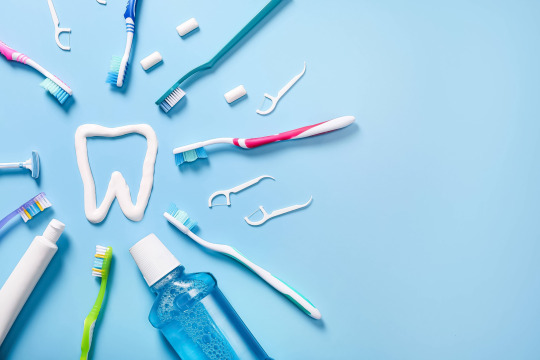
Pregnancy significantly impacts a woman's body, including her oral health, making the consequences of neglecting oral hygiene even more pronounced. During pregnancy, hormonal changes can increase the risk of developing oral health problems, such as gingivitis and periodontitis.
These conditions not only affect the mother's oral health but may also have implications for the baby's health.
Poor oral hygiene doesn't just affect the mouth. There's growing evidence to suggest a link between oral health and overall health. For instance, periodontal disease has been linked to an increased risk of heart disease, as the inflammation from the gums can potentially lead to vascular inflammation and heart problems. Additionally, oral bacteria and inflammation may also play a role in other conditions, such as diabetes and stroke.
Bad breath, or halitosis, is another common consequence of poor oral hygiene. While it may seem like a minor issue, it can be socially embarrassing and affect a person's confidence and quality of life. Furthermore, neglecting oral care can lead to the buildup of tartar and staining, which can affect the appearance of teeth and lead to the need for more intensive dental treatments, such as deep cleanings, fillings, or even extractions.
In summary, not paying attention to oral hygiene can have far-reaching consequences, affecting not only the health and integrity of your teeth and gums but also potentially impacting your overall health. It highlights the importance of regular dental care routines and professional check-ups to maintain oral health and prevent serious complications.
Choose Lema Clinic for Premier Oral and Dental Health Care
At Lema Dental Clinic, our team of experienced dentists and oral health specialists is dedicated to providing the highest standard of care. We offer a full range of dental services, from routine check-ups and cleanings to advanced procedures like implants, orthodontics, and cosmetic dentistry. Utilizing the latest technologies and techniques, we ensure effective treatment with your comfort and safety as our top priority.
Understanding that each patient's needs are unique, we offer personalized treatment plans. Our experts take the time to discuss your individual goals and concerns, crafting a tailored approach that addresses your specific oral health needs.
Lema Clinic features private consultation suites, offering a serene and comfortable environment for your dental care. We understand that your time is valuable. Our VIP services include flexible scheduling options and expedited appointments to accommodate your busy lifestyle. For patients visiting from out of town, we offer concierge services to handle all travel and accommodation arrangements, ensuring a stress-free visit.
0 notes
Text
GUM DISEASES CAUSES, STAGES, AND PREVENTION
Gum diseases, also known as periodontal diseases, are a group of conditions that affect the tissues surrounding and supporting the teeth. These diseases can range from mild inflammation of the gums (gingivitis) to more severe forms of periodontitis that can lead to tooth loss if not properly managed. Here's an overview of gum diseases:
Gingivitis: This is the mildest form of gum disease and is typically caused by the accumulation of plaque, a sticky film of bacteria on the teeth. Gingivitis is characterized by red, swollen, and bleeding gums, especially during brushing or flossing. It is usually reversible with good oral hygiene practices, including regular dental cleanings.
Periodontitis: If gingivitis is left untreated, it can progress to periodontitis. In this stage, the inner layer of the gum and bone pull away from the teeth, forming pockets that become infected. Over time, these pockets can deepen, and the supporting bone can be lost. Periodontitis can lead to tooth mobility and even tooth loss.
Aggressive Periodontitis: This is a severe form of periodontal disease that occurs in otherwise healthy individuals. It usually begins in childhood or early adulthood and affects a small number of people. It can progress rapidly, leading to significant destruction of the bone and tooth loss.
Chronic Periodontitis: This is the most common form of periodontal disease and typically occurs in adults. It is characterized by the inflammation of the supporting tissues of the teeth, progressive attachment loss, and bone loss. It often progresses slowly but can lead to tooth mobility and tooth loss if not properly managed.
Necrotizing Periodontal Disease: This is an infection characterized by the death of gum tissues, tooth ligaments, and the underlying bone. It is more common in individuals with suppressed immune systems, such as those with HIV or malnutrition.

Preventing gum diseases involves maintaining good oral hygiene practices, including regular brushing, flossing, and dental check-ups. Smoking cessation, a balanced diet, and managing conditions like diabetes can also reduce the risk of gum diseases.
Early detection and prompt treatment by a dental professional are crucial to managing gum diseases effectively and preventing complications.
Preventing Gum Diseases: Tips for Healthy Gums and Teeth
Preventing gum diseases is essential for maintaining good oral health. Here are some key strategies to help prevent gum diseases:
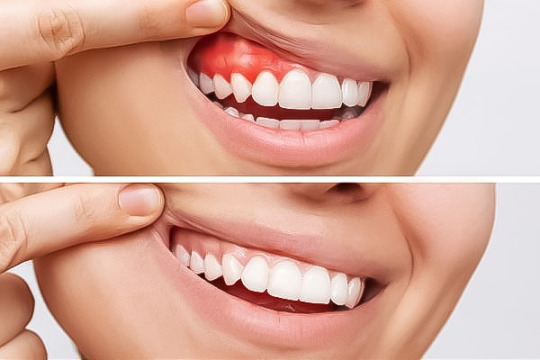
Maintain Proper Oral Hygiene:
Brush your teeth at least twice a day using fluoride toothpaste.
Floss daily to remove plaque and food particles from between your teeth and along the gumline.
Use an antiseptic or fluoride mouthwash to kill bacteria and strengthen tooth enamel.
Regular Dental Check-Ups:
Visit your dentist for regular check-ups and professional cleanings.
Dental professionals can detect early signs of gum disease and provide necessary treatments.
Quit Smoking:
Smoking is a significant risk factor for gum diseases. Quitting smoking can improve your oral health and reduce the risk of gum disease.
Balanced Diet:
Eat a diet rich in fruits, vegetables, whole grains, lean protein, and dairy products. Avoid excessive sugar and acidic foods that can contribute to gum problems.
Stay Hydrated:
Drinking water helps maintain saliva production, which is essential for washing away food particles and neutralizing acids.
Manage Stress:
High stress levels can affect your immune system and increase the risk of gum diseases. Practice stress-reduction techniques such as meditation or yoga.
Avoid Teeth Grinding:
If you grind your teeth, consider using a mouthguard. Teeth grinding can lead to gum problems and other oral health issues.
Correct Dental Issues:
Address dental problems like misaligned teeth or ill-fitting dental appliances promptly. These issues can contribute to gum disease if left untreated.
Medication Review:
Some medications can affect oral health. Consult your healthcare provider or dentist if you are concerned about the side effects of your medications.
Pregnancy and Hormonal Changes:
If you are pregnant, pay special attention to oral hygiene as hormonal changes during pregnancy can increase the risk of gum disease.
By following these preventive measures and maintaining good oral hygiene practices, you can significantly reduce the risk of gum diseases and ensure the health of your gums and teeth. Regular dental check-ups are crucial for early detection and treatment if any issues arise.
Choose Lema Clinic for Advanced Gum Disease Treatments
When it comes to treating gum diseases, Lema Clinic is a trusted name in providing state-of-the-art solutions and compassionate care. Our clinic offers a wide range of advanced treatments, ensuring that patients receive the best care for their oral health needs.
At Lema Dental Clinic, we understand that gum diseases come in various forms and stages. Lema Clinic is committed to staying at the forefront of dental technology. We utilize cutting-edge equipment and techniques, such as laser therapy for periodontal treatments, to provide more comfortable and efficient care. Every patient's gum disease is unique, and we believe in personalized treatment plans tailored to their specific needs and goals. Our approach involves thorough evaluations, open communication, and patient education to empower individuals to take control of their oral health.
Choose Lema Clinic for comprehensive gum disease treatments that prioritize your oral health and overall well-being. Your journey to healthier gums starts here.
0 notes
Text
GUM GRAFT SURGERY RESTORING HEALTY SMILES
Gum graft surgery, also known as gum tissue grafting or periodontal plastic surgery, is a dental procedure aimed at restoring and improving the health and appearance of gum tissue. This surgery is commonly performed to treat gum recession, a condition where the gum tissue pulls away from the teeth, exposing the roots. In this article, we will delve into the details of gum graft surgery, its benefits, and what to expect during and after the procedure.
What Is Gum Graft Surgery?
https://lemaclinic.com/update/wp-content/uploads/gum-graft.jpg.png
Gum graft surgery involves the transplantation of healthy gum tissue from one area of the mouth (donor site) to the area with gum recession (recipient site). The goal is to cover exposed tooth roots, reduce sensitivity, and enhance the overall aesthetics of the smile.
Common Reasons for Gum Graft Surgery
The primary indication for gum graft surgery is to address gum recession caused by factors such as aggressive tooth brushing, gum disease, or genetics.Exposed tooth roots can lead to increased sensitivity to hot, cold, or sweet foods and beverages. Gum grafts can alleviate this discomfort. Graft can enhance the appearance of the smile by creating a more symmetrical and balanced gumline.
Types of Gum Grafts
There are different techniques for gum graft surgery:
Connective Tissue Graft: This is the most common method, where a small flap of tissue is taken from the palate (roof of the mouth) and then stitched onto the recipient site.
Free Gingival Graft: In this approach, a small amount of tissue is directly removed from the palate and attached to the recipient site.
Pedicle Graft: This technique uses nearby gum tissue to cover the exposed roots, without completely detaching it from the donor site.
The Gum Graft Procedure:
Consultation: The process begins with a consultation with a periodontist or dentist who will evaluate your condition and determine the most suitable grafting technique.
Anesthesia: Local anesthesia is administered to ensure the procedure is painless and comfortable.
Donor Tissue Harvesting: The gum tissue is harvested from the selected donor site.
Recipient Site Preparation: The exposed tooth roots are thoroughly cleaned and prepared for grafting.
Graft Placement: The harvested tissue is delicately placed and sutured onto the recipient site.
Healing: Over time, the grafted tissue integrates with the existing gum tissue, providing the desired coverage and protection for the tooth roots.
Gum Graft Aftercare
Gum graft surgery can be an effective solution for treating gum recession and enhancing your oral health. However, a crucial aspect of the success of this procedure lies in the aftercare and recovery process. In this article, we will explore essential steps and tips for gum graft aftercare to ensure a smooth and successful recovery.
Follow Post-Operative Instructions: After your gum graft surgery, your periodontist or dentist will provide you with specific post-operative instructions. These instructions are tailored to your case and are essential for a successful recovery. It's crucial to follow them diligently.
Maintain Good Oral Hygiene: Proper oral hygiene is vital during the recovery period. However, you should avoid brushing or flossing the treated area until your dentist gives the green light. In the meantime, you can use an antimicrobial mouthwash as recommended by your dentist to keep the surgical area clean.
Soft Diet During Healing: For the first few days following gum graft surgery, it's advisable to stick to a soft diet. Avoid hard, crunchy, or spicy foods that could irritate the surgical site. Opt for smoothies, yogurt, mashed potatoes, and other soft, easy-to-chew options.
Manage Discomfort: Some discomfort and swelling are common after gum graft surgery. Your dentist may prescribe pain medication to manage pain. Applying an ice pack to the outside of your face for short intervals can also help reduce swelling.
Rest and Avoid Strenuous Activities: Rest is essential during the initial days of recovery. Avoid strenuous activities and exercise, as this can increase blood flow and potentially disrupt the healing process.
Stay Hydrated: Drinking plenty of water is important to stay hydrated and aid in the healing process. Proper hydration supports overall health and can contribute to a smoother recovery.
Avoid Smoking and Alcohol: Smoking and alcohol can hinder the healing process and may increase the risk of complications. It's best to refrain from these habits during the recovery period.
Attend Follow-Up Appointments: Make sure to attend all scheduled follow-up appointments with your dentist or periodontist. These appointments are crucial for monitoring your progress and ensuring that the graft is healing as expected.
Be Patient: Gum graft surgery recovery takes time. It may take several weeks for the grafted tissue to fully integrate and for you to experience the full benefits of the procedure. Be patient and trust the process.
Maintain Regular Dental Check-Ups: Even after you have fully recovered, it's important to continue with regular dental check-ups and cleanings. This will help prevent gum recession from returning and maintain your improved oral health.
In conclusion, gum graft surgery can significantly benefit your oral health, but proper aftercare is essential for a successful recovery. By following your dentist's instructions, maintaining good oral hygiene, and taking steps to promote healing, you can ensure that your gum graft procedure leads to a healthier and more comfortable smile.
Benefits of Gum Graft Surgery
Gum grafts help restore gum tissue, reducing the risk of further recession and gum disease. Reduced tooth sensitivity and discomfort when consuming hot or cold foods.Gum grafts can enhance the appearance of the smile, creating a more youthful and balanced gumline.
In conclusion, graft surgery is a valuable dental procedure for restoring gum health, reducing sensitivity, and improving the aesthetics of the smile. If you are experiencing gum recession or sensitivity, consult with a dental professional to determine if gum graft surgery is the right solution for you.
Why Choose Lema Dental Clinic for Gum Graft Surgery: Reliability and VIP Services
When it comes to gum graft surgery, choosing the right dental clinic is paramount to a successful and comfortable experience. Lema Dental Clinic has earned a reputation for reliability and excellence in providing VIP services for patients undergoing gum graft procedures.
Lema Dental Clinic is known for its unwavering commitment to patient care and safety. With a team of experienced periodontists and dental professionals, the clinic offers a high level of expertise in performing gum graft surgeries. Patients can trust the skill and knowledge of the clinic's staff for reliable and effective treatments.
The clinic utilizes state-of-the-art dental technology to ensure precision and comfort during gum graft surgery. Advanced equipment and techniques contribute to the clinic's reputation for delivering successful outcomes with minimal discomfort.
Lema Clinic has earned the trust of its patients through transparent communication, ethical practices, and a patient-centric approach. Patients can rely on the clinic for honest advice and top-notch care.
In conclusion, when considering gum graft surgery, Lema Dental Clinic stands out as a reliable and trustworthy choice. With a dedication to excellence, cutting-edge technology, personalized care, and VIP services, the clinic ensures that patients receive the highest quality treatment while feeling valued and comfortable throughout the process.
0 notes
Text
UNDERSTANDING DENTAL PHOBIA
Dental phobia, also known as dentophobia or odontophobia, is a specific kind of anxiety disorder characterized by an intense, irrational fear of dental procedures, dentists, or dental environments. This phobia can be particularly challenging, as it often leads to the avoidance of necessary dental care, impacting oral and overall health.
Origins of Dental Phobia

The causes of dental phobia can vary greatly among individuals. Common origins include previous traumatic experiences during dental procedures, fear of pain or discomfort associated with dental treatments, and negative stories or portrayals of dentistry in media and culture. For some, the fear may also be related to a general anxiety disorder.
Psychological Components
Dental phobia is deeply embedded in psychological responses to fear and anxiety. It may involve fear of pain, fear of needles, fear of loss of control in a dental setting, or fear of being judged for one's dental condition. The phobia can be standalone or associated with other phobias and anxiety disorders.
Impact on Oral Health
The most significant impact of dental phobia is the neglect of oral health. Avoidance of regular dental check-ups and treatments can lead to the progression of dental diseases, chronic pain, and even systemic health issues linked to poor oral health. This avoidance can create a vicious cycle, where dental conditions worsen, further increasing fear and anxiety.
In conclusion, dental phobia is a serious and complex issue that affects a significant number of individuals. It is characterized by an overwhelming fear of dental situations, which can lead to detrimental consequences for oral health. Understanding the nature of this phobia is crucial, as it highlights the challenges faced by individuals in seeking and receiving essential dental care.
Recognizing the Symptoms of Dental Phobia

Dental phobia, a significant fear of dental visits or treatments, is more than just feeling uneasy about going to the dentist.
It's a severe anxiety that can have profound effects on an individual's overall health and well-being. Understanding the symptoms of dental phobia is crucial for recognizing and addressing this issue.
Here’s an overview of the common symptoms:
Intense Anxiety and Dread: The most noticeable symptom of dental phobia is an overwhelming sense of anxiety or dread when thinking about the dentist. This feeling can start days or even weeks before a scheduled appointment.
Physical Symptoms: Physical manifestations of this anxiety can include sweating, increased heart rate, shaking, nausea, or even fainting at the thought of a dental visit.
Avoidance Behavior: People with dental phobia often go to great lengths to avoid dental appointments. This can include canceling or repeatedly rescheduling visits, or avoiding the dentist altogether until the pain or dental issues become unbearable.
Trouble Sleeping: The prospect of an upcoming dental appointment can lead to sleep disturbances, including trouble falling asleep or experiencing nightmares related to dentistry.
Emotional Distress: Dental phobia can trigger feelings of stress, embarrassment, and even guilt over dental neglect. This can lead to a cycle of anxiety, where the fear of judgment further exacerbates the phobia.
Panic Attacks: In more severe cases, just the thought of dental treatment can trigger a panic attack, characterized by shortness of breath, dizziness, and a feeling of loss of control.
Impact on Daily Life: Dental phobia can have a broader impact on life, affecting personal and professional activities due to the stress and anxiety associated with the phobia.
Understanding these symptoms is the first step towards acknowledging and addressing dental phobia. It’s important to recognize that dental phobia is a common issue and can be managed with the right approach and support.
Strategies to Overcome the Fear of Dentists
Dental phobia, the fear of dental visits or procedures, can be a significant obstacle to maintaining good oral health. Here are some effective strategies for managing this fear:
Understanding the Root Cause: Identifying the source of your fear is the first step towards managing it. Dental phobia often stems from past negative experiences, fear of pain, or a feeling of losing control.
Gradual Exposure: Start with small, less intimidating steps. This might mean initially visiting the dental office just to meet the dentist in a non-treatment setting.
Communication: Openly discuss your fears with your dentist. Many dental professionals are trained to handle phobic patients and can adjust their approach accordingly.
Relaxation Techniques: Practice relaxation methods such as deep breathing, meditation, or listening to calming music during appointments.
Distractions: Use distractions like watching TV, listening to music, or focusing on a visual aid in the dental office to reduce anxiety during procedures.
Seeking Professional Help: In severe cases, consulting a psychologist or a therapist who specializes in phobias can be beneficial. They can provide therapy options such as cognitive-behavioral therapy (CBT) to address the underlying anxiety.
Sedation Options: Discuss with your dentist about sedation dentistry. This can include options like nitrous oxide ("laughing gas"), oral sedatives, or even general anesthesia for more severe cases.
Positive Reinforcement: Reward yourself after each successful dental visit. This can help create positive associations with dental care.
Education: Learning more about dental procedures and what to expect can demystify the process and alleviate fears.
Choosing the Right Dentist: Find a dentist who is experienced in treating patients with dental phobia. A supportive and understanding dental team can make a significant difference.
Remember, overcoming dental phobia is a process, and it's okay to take it one step at a time. With the right strategies and support, it is possible to manage this fear and maintain good oral health.
Overcoming Dental Phobia with Lema Dental Clinic
At Lema Dental Clinic, we understand that visiting the dentist can be a daunting experience for many. That's why we've created an environment where overcoming dental phobia is not just a possibility, but a reality. Our commitment to your comfort starts the moment you step through our doors.
Trust is the cornerstone of our approach at Lema Clinic. We believe in building a relationship with our patients based on understanding, respect, and open communication. This foundation allows us to create a safe space for those with dental phobia.
Knowledge is power, and at Lema Dental Clinic, we empower our patients by educating them about their dental health and procedures. Understanding what to expect can significantly reduce anxiety and help build confidence in dental care. Overcoming dental phobia is a journey, and at Lema Clinic, we are ready to walk that path with you. Our goal is not just to provide exceptional dental care but to transform your view of dentistry into a positive, fear-free experience.
Your dental health is important, and so is your comfort. Let Lema Dental Clinic help you overcome your dental phobia in an environment where expertise, care, and trust come together to create the best dental experience you can have.
0 notes
Text
THE POWER OF 100% DIGITAL SMILE DESIGN
100% Digital Smile Design is a modern dental treatment approach that utilizes advanced digital technology to create and plan a new smile for patients. This method is highly personalized and precise, allowing dental professionals to design smiles that are in perfect harmony with the patient's facial structure and aesthetic preferences.
The process begins with a detailed digital analysis of the patient's teeth, gums, and facial features. High-resolution digital images, scans, and sometimes 3D models of the patient's mouth are used to get a comprehensive view of the current dental structure. With this digital data, dentists can simulate and plan the ideal smile, taking into account aspects like tooth size, shape, color, and overall alignment.
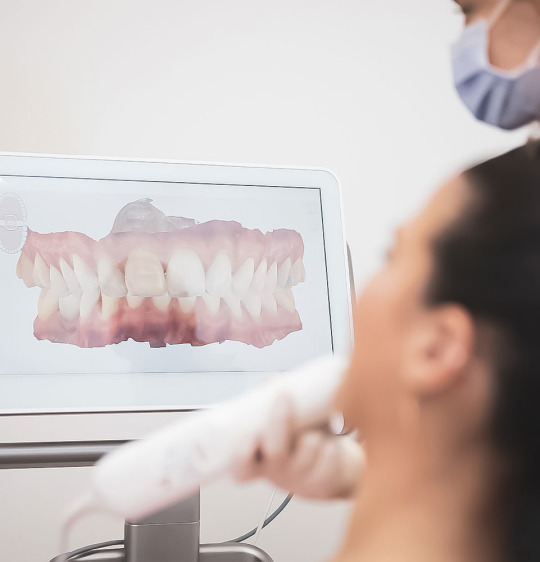
One of the key features of Digital Smile Design is its collaborative nature. Patients are actively involved in the design process, where they can see the proposed changes before any actual dental work begins. This allows for adjustments and ensures that the final result aligns with the patient's expectations.
Once the design is finalized, the dental procedures, which might include veneers, crowns, implants, or orthodontics, are carried out with precision. The use of digital technology not only enhances accuracy but also improves the efficiency of the entire process.
In summary, 100% Digital Smile Design is a sophisticated approach in cosmetic dentistry that combines digital technology with dental expertise to create customized, aesthetically pleasing smiles.
This method offers predictability, patient involvement, and highly accurate results, making it a popular choice for those seeking to enhance their smile.
Excellence in 100% Digital Smile Design: Lema Dental Clinic's Pioneering Approach
At Lema Dental Clinic, we take pride in being at the forefront of dental innovation, particularly in our 100% Digital Smile Design services. Lema Clinic stands out not only for its advanced technology but also for offering a comprehensive and luxurious dental experience to our patients.
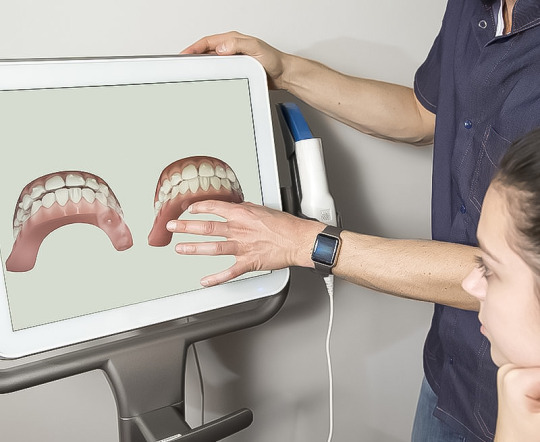
Unparalleled Expertise in Digital Smile Design: Our success in Digital Smile Design lies in the perfect blend of cutting-edge technology with our team's extensive expertise. We use high-resolution digital imaging and sophisticated software to create precise and personalized smile designs.
VIP Services for a Luxurious Experience: Understanding that dental visits can be stressful, Lema Clinic offers VIP services to ensure utmost comfort and exclusivity. Our VIP patients enjoy personalized attention, extended consultations, and luxury amenities, making their dental experience as comfortable and relaxing as possible.
Comprehensive Dental Treatment Spectrum: In addition to Digital Smile Design, Lema Dental Clinic offers a wide array of dental services. From routine check-ups and cleanings to more complex procedures such as dental implants, orthodontics, and cosmetic dentistry, we cover all aspects of dental care. Our holistic approach to dental health means we not only focus on aesthetics but also on the functional and long-term health of your teeth and gums.
A Commitment to Excellence and Patient Satisfaction: At Lema Clinic, every patient is a priority. We are committed to delivering exceptional results and ensuring patient satisfaction. Our team continuously stays updated with the latest dental techniques and trends to provide the best possible care.
Why Choose Lema Dental Clinic for Digital Smile Design?
State-of-the-art technology for precision and accuracy in smile design
Experienced dental professionals dedicated to creating the perfect smile
Tailored VIP services for a comfortable and exclusive experience
A wide range of dental treatments to meet all dental needs
A commitment to patient satisfaction and excellence in dental care
In conclusion, Lema Clinic's 100% Digital Smile Design service is more than just a dental procedure; it's a testament to our dedication to innovation, excellence, and comprehensive patient care. Whether you're seeking a complete smile makeover or comprehensive dental care, Lema Dental Clinic is your destination for exceptional dental services.
0 notes
Text
TOOTH EXTRACTION PROCESS AND AFTERCARE
Tooth extraction, a common dental procedure, involves the removal of a tooth from its socket in the bone. Typically performed by a dentist or an oral surgeon, extractions are necessary for various reasons: severe tooth decay, infection, overcrowding, or impacted wisdom teeth. The process begins with an examination, followed by an X-ray to plan the best approach. Modern techniques and anesthesia ensure a relatively painless experience. Post-extraction care is crucial for healing, involving guidelines like avoiding certain foods and activities. Understanding this procedure can alleviate concerns, making it a less daunting experience for patients.
Tooth Extraction Process
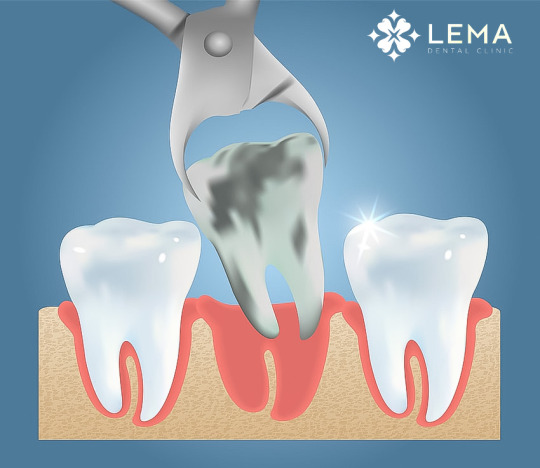
Tooth extraction is a dental procedure that involves the removal of a tooth from its socket in the jawbone.
While the thought of extraction can be intimidating, understanding the process can help alleviate anxiety.
Why Tooth Extraction is Needed Common reasons for tooth extraction include severe decay, infection, impacted wisdom teeth, or to create space for orthodontic treatment.
In some cases, a damaged tooth may also need to be removed if it cannot be repaired.
The Extraction Procedure
Initial Examination: The dentist first examines the tooth and takes an X-ray to determine the best approach for removal.
Anesthesia: To ensure comfort, local anesthesia is applied to numb the area around the tooth. In some cases, sedation may be used.
The Extraction: For a simple extraction, the dentist loosens the tooth with a tool called an elevator, then uses forceps to remove it. Surgical extractions, required for more complex cases like impacted teeth, involve making an incision in the gum.
Post-Extraction Care: After the tooth is removed, the dentist will provide instructions on how to care for the extraction site. This typically includes bite down on a piece of gauze to control bleeding and promote clotting, avoiding certain foods and activities, and taking prescribed pain relief if necessary.
Healing and Recovery Recovery time varies, but most people start to feel more comfortable within a few days. It's important to follow the dentist's aftercare instructions to prevent complications like dry socket, where the blood clot at the extraction site is dislodged.
Post-Tooth Extraction Care
Bite Down on Gauze: Immediately after extraction, bite gently but firmly on a piece of sterile gauze placed over the extraction site. This helps to control bleeding and allows a blood clot to form in the socket, which is vital for healing.
Rest: Plan to rest for at least 24 hours post-extraction. Avoid any strenuous activities as they can increase bleeding.
Use Painkillers as Prescribed: If your dentist prescribes painkillers, use them as directed. Over-the-counter pain relievers can also be effective.
Apply Ice Packs: To reduce swelling, apply an ice pack to the cheek near the extraction site for 10 minutes at a time.
Soft Foods: Stick to soft foods like yogurt, pudding, soup, and applesauce for the first few days. Gradually reintroduce solid foods as your extraction site heals.
Avoid Hot Liquids and Alcoholic Beverages: Hot beverages can dissolve the blood clot, and alcohol can hinder the healing process.
Do Not Disturb the Extraction Site: Avoid rinsing, spitting, or using a straw for the first 24 hours as these actions can dislodge the blood clot.
Gentle Rinse: After 24 hours, gently rinse your mouth with warm salt water several times a day to reduce swelling and relieve pain.
Watch for Dry Socket: If the blood clot gets dislodged prematurely, it can lead to a painful condition known as dry socket. If you experience severe pain a few days after extraction, contact your dentist.
No Smoking: Smoking can impede the healing process and should be avoided.
Attend Follow-Up Appointments: Visit your dentist for a follow-up appointment if it’s scheduled, especially if you have stitches or if complications arise.
In conclusion, taking good care of yourself after a tooth extraction is essential for healing and avoiding complications. Always follow the specific guidelines provided by your dentist and contact them if you have any concerns during your recovery.
Embracing New Smiles: The Positive Impact of Dental Implants After Tooth Extraction
Losing a tooth doesn't have to be the end of your beautiful smile. Thanks to advancements in dental technology, dental implants offer a fantastic solution, turning a moment of loss into an opportunity for restoration and even improvement.

Dental implants stand as a beacon of hope in modern dentistry. They are not just replacements for missing teeth; they are complete restorations, from root to crown.
The implant, a titanium post, is expertly placed into the jawbone, where it fuses naturally, forming a robust foundation just like a natural tooth root. This fusion not only provides exceptional stability for the new tooth but also promotes healthy jawbone maintenance, preventing the bone loss that often follows tooth extraction.
The journey to a renewed smile with dental implants is a story of transformation. Once the implant integrates with the jawbone, a custom-made crown that perfectly matches the color, shape, and size of your natural teeth is attached. This new tooth isn’t just a functional addition; it restores the fullness of your smile and the confidence that comes with it.
What truly sets dental implant apart is their ability to offer a new chapter in your dental story. They are a long-term solution, known for their durability and functionality. They don't just fill a gap; they offer a chance to maintain, or even enhance, the natural harmony of your teeth.
In summary, dental implants post-tooth extraction are more than just a dental procedure; they are a pathway to reclaiming and enhancing your smile. They stand testament to the resilience and innovation of dental care, ensuring that a lost tooth doesn’t mean a lost smile.
Tooth Extraction and Implant Services at Lema Dental Clinic
Lema Dental Clinic has established a distinguished reputation in the field of dentistry, particularly excelling in tooth extraction and implant procedures. Our clinic combines years of experience with the latest technology to provide patients with exceptional care and successful outcomes.
At Lema Dental Clinic, tooth extractions are performed with utmost precision and care. Understanding the anxiety often associated with this procedure, our experienced dental professionals ensure a comfortable and stress-free experience for our patients. Lema Clinic truly shines in the area of dental implants. We pride ourselves on our success rate, which is a testament to our expertise and the cutting-edge technology we employ. From the initial consultation to the final placement of the implant, our team is dedicated to delivering personalized care. We meticulously plan each implant procedure, using detailed imaging and diagnostics to ensure optimal placement and aesthetics. Our skilled dentists are not just experts in implant surgery; they are also artisans who craft each implant to flawlessly match the patient’s natural teeth, enhancing both functionality and appearance.
Our commitment to excellence in tooth extraction and dental implants is reflected in the high satisfaction of our patients. Lema Dental Clinic’s combination of experienced professionals, state-of-the-art technology, and a patient-centered approach sets us apart as a leader in dental care.
0 notes